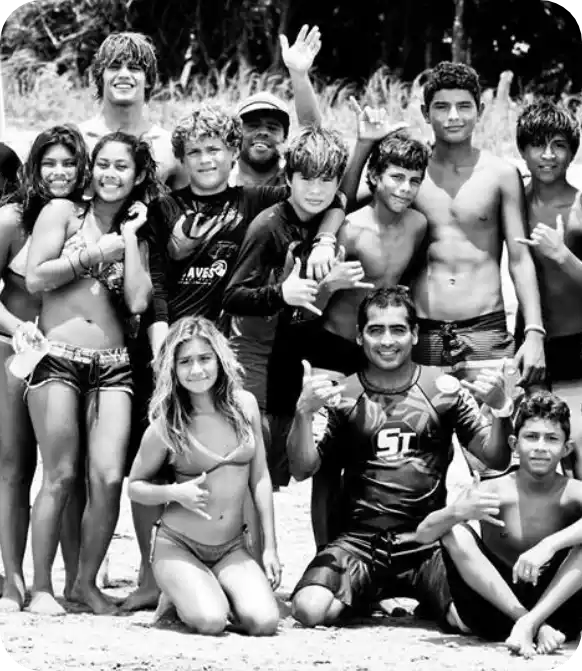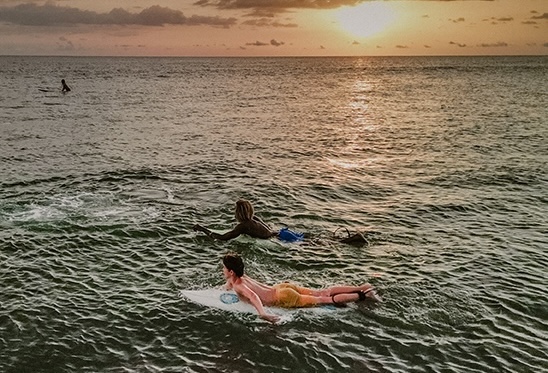Who We Are?
A team with 20 years of surfing experience teaching with professionalism & safety
How we started...
Mauricio Ortega is the founder of the Avellanas Surf School. Mauricio moved from San Jose to Avellanas Beach when he was 15 years old. There he was mentored in surfing by a local by the name of Freddie who had been living and surfing there since the 1970’s. Freddy became his teacher and from then on surfing became his passion and his lifestyle.
In 1998 Mauricio moved to Playa Tamarindo and worked as a bartender. While bartending he met a French family who asked him to teach their children how to surf. So, without any teaching experience Mauricio dove right in. The French were surfing! Through this opportunity, he had the idea of starting his own surf school. Shortly afterward, Mauricio partnered up with another to form the first full-fledged surfing business on the coast.


All of these years of experience have allow us to maintain our main goal, which is to teach you surfing with professionalism and safety.

We make sure that you and your family will be able to enjoy the surf, our costarican surfing life style, the people and its natural beauty.

We take safety very seriously to choose the most knowledgeable local surf instructor to help you with your technique and skills in a very personal, safe and humble way.

We want you to be part of our family here in playa Avellanas, sharing with you and ensuring that your vacation becomes unforgettable.
Your family’s safety is first!

The surf school experience in Costa Rica has exploded over the last 10 years. Places like Playa Tamarindo and other beaches all over Costa Rica are rich with many choices of surf schools. There are a lot of options. We advise you to research and take your family’s safety very seriously.
At the Avellanas Surf School, with 10 years of operation, our instructors are local surfers with the proper knowledge and training that comes with years of experience. Our “Surf Coaches” know the surf breaks, the currents, and the reefs. They are real surfers that are ready to share their experience with you and to ensure that you learn to surf in the safest conditions, enjoy your surroundings and have fun doing it.
Your Family’s safety is our first priority.
Surfing naturally involves some risks, but as in every outdoor sport real risk is minimized if our level and form are in the right relationship with the difficulty of the respective situation. That requires knowing how to properly assess both our level and the sea conditions.
It is true that you can learn the necessary theory and safety rules through reading but what you cannot do through reading books is acquire the ability to correctly assess the situation in the water. That is exactly why it is not advisable to abandon the support of an experienced surf instructor.

What you could do before your surf holiday . . .
Physically prepare yourself before your holiday by swimming, snorkeling, and practicing skateboarding.
(Our recommendation: paddling with a surfboard in a prone position into a lake, river, or pool to get used to the control you will need with the board)
Like this you will enjoy surfing more from the beginning of your holiday, being in a better physical condition will ultimately provide more security in practice.
The following is important to know before you get into the water
– Characteristics of the shoreline and seabed, rocks or coral
– Sandbanks and places of risk with possible currents
– Direction and intensity of possible currents
– Effects of the oceans
– Other hazards
– Location of your emergency responders and emergency telephone number
Never place yourself in waves if you cannot swim back to the shore from that position without a surfboard, because the leash can tear or break!!!
New beaches are exciting
but . . .
Before you
start . . .
At any beach you go to, always before you go in, you should look at the waves and check the status and your equipment:
– Are there currents?
– The height of the waves and how they break?
– How many waves are there in one set? How much time passes between two sets?
– What do other surfers do?
– Is there a dumping shore break (hollow waves that break right on the shore)?
– Is the leash flawless?
– Are the fins well attached to the board?
– Does the board have enough wax?
– Are you wearing a suit that gives you enough insolation?
– Are you protected from the sun?
– You’re in good physical and mental shape?
– Your level and your form are sufficient for sea conditions?
– Never go alone when there are dangerous conditions!
– Under non-hazardous conditions, at least one person would watch you from the beach!
– Never carry your board between your body and the wave, if you’re not on the board always carry it to your side!
At last the water . . .
At the peak . . . waiting for the waves . . .
– Always look at the waves!
– Often look at the shore to see if the current is taking you.
– Always when you’re not catching waves or paddling, you should sit on your board so you’ll see the waves in advance, others will be able to see you better and you can turn faster.

